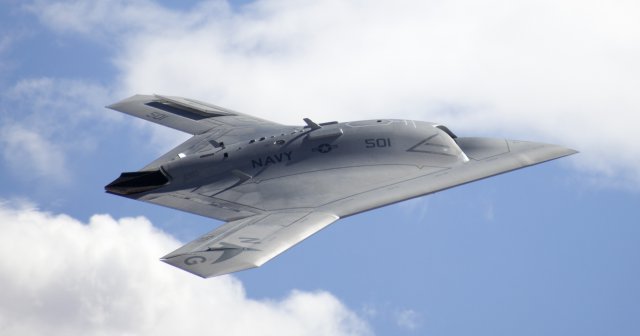 Most aircraft slated to go onto aircraft carriers have to go through an electronic magnetic interference test that bathes the design in about 200 volts per meter.
Most aircraft slated to go onto aircraft carriers have to go through an electronic magnetic interference test that bathes the design in about 200 volts per meter.
But the test platform for the Navy’s unmanned carrier-launched airborne surveillance and strike (Uclass) aircraft programme, will have to endure 10 times the electronic stress.
An X-47B test aircraft is being prepared for its move into the anechoic chamber at NAS Patuxent River, Md. It must be able to survive and operate in an environment of a stunning 2,000 volts per meter.
Undoubtedly that means the Navy wants a design for its unmanned carrier-launched airborne surveillance and strike (UCLASS) aircraft program that would be able to fire a permanently installed, rechargeable, anti-electronics weapon. Such a high-power microwave device could be used at close range against enemy systems – such as sophisticated, long-range air defenses – without damaging the UCLASS system’s own electronics.
“We will spend the better part of this spring doing electromagnetic compatibility testing,” says Capt. Jaime Engdahl who represents the unmanned combat air system demonstration (UCAS-D) program. “Does [the future unmanned carrier-launched surveillance and strike system (UCLASS) aircraft] have to be the [X-47B size]?” he says. “It was developed under the JUCAS program and was sized for an internal weapons bay to carry 4,500 lb. of weapons and some electronic warfare weapons.”
Congress is already weighing in on the Navy’s future unmanned strike options. A draft defines authorization bill keeps four major contractors – General Atomics, Lockheed Martin, Northrop Grumman and Boeing – alive in the hunt for the Unmanned Carrier-Launched Surveillance and Strike System (UCLASS) until 2016, stipulating that the program remain in the critical design review phase until that time.
Right now the Navy’s unmanned strike aircraft programme is proceeding with two Northrop Grumman X-47B test aircraft. One (AV-1) is at NAS Patuxent River, Md. being readied for electro-magnetic interference (EMI) testing before beginning an autonomous aircraft carrier landing program. It is to demonstrate the very first carrier-based catapults and arrested landings in 2014.
The other (AV-2) is at Edwards AFB, Calif. in a flight test program and will eventually be used to autonomously find and rendezvous with two tankers, Engdahl says who provided an update on the unmanned combat air system demonstration program. That will be followed by an approach, a plug-in and the receipt of 3,000 lb. of fuel. One tanker will have a Navy probe and drogue refueling system. The other will have an Air Force type boom refueling system.
Source: Aviation Week
